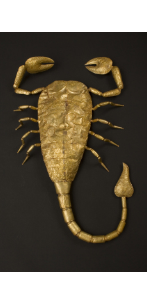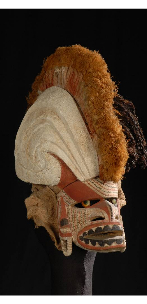Two Masks
Two objects: it seems that they have only one thing in common: both are masks. What can they tell us together? Maybe they can help us step beyond time only by being with us.
| Wilhelm Gábor |
2011-04-12 22:31 |
 The South East Scorpion
The South East Scorpion
The first mask presents a scorpion. In fact it is one of a pair, where the two objects separately form a scorpion. The presentation is surprisingly effective. The legs, the tentacles, the sections of the tail, the claws are all meticulously elaborated. By examining the decoration and formation it is clear that the mask was made in South East Asia and was used there as well. More details can only be obtained from collectors. According to their knowledge the scorpions are originated from one of the tribes living on the plains of Middle Vietnam. To gain even more information about the objects, we have to analyze them.
The back and claws of the scorpion pair are finely ornamented. The decoration consists of spirals, wavy lines, leaf patterns and triangles, on the back side of the each mask a human portray can be seen. From the shape of the face one presents a man, the other a woman.
The masks must have belonged to the leaders of a tribe. They are extraordinary because they are totally unique: such pieces can’t be found anywhere else in the world. Although the age of the masks is unknown, the decoration points to the so called Dong Son culture, the centre of which was in South East Asia between 2000 B.C. and 200 A.D. The usage of the scorpion masks is unknown yet but researchers assume that they were worn as masks.
The Mask of the Melanesian Death Rite
The second mask takes us on a longer journey geographically but is not as ancient as the other one. This is a so called Malangan mask, which belongs to the type of a specia l and characteristic Melanesian mask. According to the local tradition, the mask was made from different kinds of material. The face is carved of wood, the eye is indicated by painted shell, the skull part is made of shuck, held together with strings. The ridge running along the middle of the skull part imitates the headdress wearing by young men during the period of mourning. The ear is elongated and pierced, the mouth is open. All these are the characteristics of the Tatanua masks.
l and characteristic Melanesian mask. According to the local tradition, the mask was made from different kinds of material. The face is carved of wood, the eye is indicated by painted shell, the skull part is made of shuck, held together with strings. The ridge running along the middle of the skull part imitates the headdress wearing by young men during the period of mourning. The ear is elongated and pierced, the mouth is open. All these are the characteristics of the Tatanua masks.
Tatanua is the name of the dance, during the performing of which these masks were worn. The men, by going through the death rituals (Malangan) paid their respects to the deceased leaders of the community. The masks used in the ritual were carved out by specialists. The proper form and style of decoration is owned by certain families, in fact the design is always prevalent in the culture. The mask, as an object, can be seen only during the ritual, later it perishes. The masks are only used in the death rituals. In fact it is only the „inner” picture of the mask that is owned by the family and during the rituals is revived time and again.
The death mask was collected by Lajos Biró in the late 19th century. At the time he couldn't gather information on location, since of the six years he spent in New-Guinea, he stayed in New Ireland only for a month. He obtained the description later, from guest workers who came from New Ireland to the Astrobale Bay.
The Reciprocal Connection
It is clear that the two masks cannot be connected in any way. The origin of the scorpion mask is completely unknown, even its usage is still obscure. On the other hand almost everything is known about the other mask: when and where and by whom it was used, how it was made. The two types of masks however seems like they are the reciprocals of each other. In the case of the Melanesian mask the materialized form is the shortest part of the object’s life, the knowledge connected to it is almost eternal. The golden mask as an object has a long past, but there is hardly any information connected to it.
The masks can't be seen in the exhibition „Faces Concealed in Gold - Gold Masks from Asia
The Zelnik Collection” at the Museum of Ethnography
Scorpion, tribal mask
Gold
Total length: 76 cm, h: 9 cm, width: 45,5 cm
Property of István Zelnik, ZC 26
Tatanua mask of the Malangan rite
Melanesia, New Ireland, 19th century
Alstonia, lime, fiber, shell (Turbo petholatus)
Carved, painted
hight: 37 cm, width: 18 cm, depth: 37 cm
Bought from Lajos Biró, 1897
Museum of Ethnography
Photo: Krisztina Sarnyai
Szegő László - Wilhelm Gábor (szerk.):
2010 Aranyba rejtett arcok - aranymaszkok Ázsiából. A Zelnik-gyűjtemény a Néprajzi Múzeumban. Kiállításvezető. Néprajzi Múzeum - Magyar Indokína Társaság Kft., Budapest.
Jelen János - Wilhelm Gábor (szerk.):
2010 Aranyba rejtett arcok - aranymaszkok Ázsiából. A Zelnik-gyűjtemény a Néprajzi Múzeumban. Katalógus. Néprajzi Múzeum - Magyar Indokína Társaság Kft., Budapest.